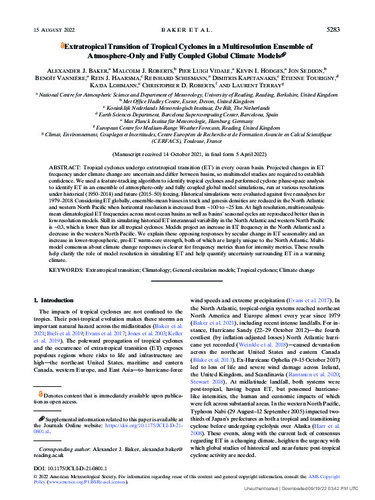Extratropical transition of tropical cyclones in a multiresolution ensemble of atmosphere-only and fully coupled global Climate Models

Cita com:
hdl:2117/372995
Tipus de documentArticle
Data publicació2022
EditorAmerican Meteorological Society (AMS)
Condicions d'accésAccés obert
Tots els drets reservats. Aquesta obra està protegida pels drets de propietat intel·lectual i
industrial corresponents. Sense perjudici de les exempcions legals existents, queda prohibida la seva
reproducció, distribució, comunicació pública o transformació sense l'autorització del titular dels drets
Abstract
Tropical cyclones undergo extratropical transition (ET) in every ocean basin. Projected changes in ET frequency under climate change are uncertain and differ between basins, so multimodel studies are required to establish confidence. We used a feature-tracking algorithm to identify tropical cyclones and performed cyclone phase-space analysis to identify ET in an ensemble of atmosphere-only and fully coupled global model simulations, run at various resolutions under historical (1950–2014) and future (2015–50) forcing. Historical simulations were evaluated against five reanalyses for 1979–2018. Considering ET globally, ensemble-mean biases in track and genesis densities are reduced in the North Atlantic and western North Pacific when horizontal resolution is increased from ∼100 to ∼25 km. At high resolution, multi-reanalysis-mean climatological ET frequencies across most ocean basins as well as basins’ seasonal cycles are reproduced better than in low-resolution models. Skill in simulating historical ET interannual variability in the North Atlantic and western North Pacific is ∼0.3, which is lower than for all tropical cyclones. Models project an increase in ET frequency in the North Atlantic and a decrease in the western North Pacific. We explain these opposing responses by secular change in ET seasonality and an increase in lower-tropospheric, pre-ET warm-core strength, both of which are largely unique to the North Atlantic. Multimodel consensus about climate change responses is clearer for frequency metrics than for intensity metrics. These results help clarify the role of model resolution in simulating ET and help quantify uncertainty surrounding ET in a warming climate.
DatasetAll reanalysis data for tropical cyclone tracking (vorticity, wind fields, and sea-level pressure) and cyclone phase-space analysis (geopotential) are available from https://rda.ucar.edu or https://disc.gsfc.nasa.gov. Model data are available from Earth System Grid Foundation nodes (https://esgf.llnl.gov). TRACK is available for download at https://gitlab.act.reading.ac.uk/track and the track datasets used in this paper may be downloaded from https://catalogue.ceda.ac.uk/uuid/e82a62d926d7448696a2b60c1925f811. Data analysis and visualization code are available from the lead author upon request (https://hrcm.ceda.ac.uk/contact).
CitacióBaker, A.J. [et al.]. Extratropical transition of tropical cyclones in a multiresolution ensemble of atmosphere-only and fully coupled global Climate Models. "Journal of Climate (JCLI)", 2022, vol. 35, núm. 16, p. 5283-5306.
ISSN0894-8755
1520-0442
1520-0442
Col·leccions
| Fitxers | Descripció | Mida | Format | Visualitza |
|---|---|---|---|---|
| [15200442 - Jou ... Global Climate Models.pdf | 11,20Mb | Visualitza/Obre |

